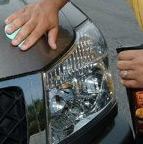What is a Clay Bar?
A clay bar is used to remove contaminants like asphalt, paint over spray, brake dust, metal fragments, rail rust and, brake dust off your car’s surface.
Yes it is the same clay you played with as a kid but the difference is that detailing clay is much more flexible which allows it to be stretched and kneaded repeatedly without losing its density. Also detailing clay would be able to pick up contaminants off your car’s finish that can pierce through the clear coat a normal car wash cannot clean.
How does it work?
 As you rub the detailing clay over the surface it grabs all the contaminants that’s adhering on the paint, as a result the particles stick on the clay leaving behind a mirror-smooth finish. When used correctly the detailing clay will not scratch the paint.
As you rub the detailing clay over the surface it grabs all the contaminants that’s adhering on the paint, as a result the particles stick on the clay leaving behind a mirror-smooth finish. When used correctly the detailing clay will not scratch the paint.
Detailing clay needs a clay lubricant to be used effectively and prevent scratches on the paint.
What does it remove?
Everyday your car is exposed to a lot of air-born pollutants like brake dust, acid rain, rail dust and asphalt, all can cling to the paint. All these pollutants have tiny metal particles in them that can penetrate the clear coat and harm the base coat behind it. These contaminants will oxidize and eventually rust below the clear coat that can eventually lead to paint failure.
Clay bar will also remove hard to clean bugs, tar, and tree sap. You can also use it on your car’s windows and other surfaces like plastic and metal.
Will clay remove swirl marks or scratches?
No, it will only remove surface contaminants. To remove swirls or scratches, you need a polish or compound for this purpose depending on the severity of these imperfections.
How do I know that I need to clay?
After washing your car, run your fingers over the surface, if it feels rough you will need to clay your car.
You can also use the bag test were you simply put your hands inside a sandwich bag and rub the surface of the car with it. The purpose of the sandwich bag is to magnify the sense of touch on your fingertips as you try to feel for contaminants on the paint.
As an added benefit when you clay before applying wax or sealant it will stick better on the paint giving a deeper and brilliant shine.
How often do I need to clay?
You can clay as often as monthly or spot clean the affected areas weekly. It will all depend on several factors – environment, where you park your car, how often you wash or wax. After cleaning your car run your fingers on the paint to check the smoothness or shall I say roughness to find out. A rough surface means you need to clay that section. If you are going do this weekly or monthly get a fine grade clay bar for this task.
How do I use a clay bar?
Make sure you have a clay lubricant in hand before you start, using soapy water as a lubricant will prematurely degrade the clay bar.
1. Wash your vehicle.
2. Before using the clay bar make sure to mold it until the clay bar becomes flexible and then flatten to a disc shape.
3. Spray clay lubricant on the clay bar and the section you are going to work on, roughly around two square feet.
4. Carefully glide the clay bar back and forth over the saturated area, at first it will feel sticky but as you rub the clay over the surface it will glide over more and more smoothly as you feel and hear it pick up contaminants. Keep going until it glides smoothly and you no longer feel contaminants on the paint.
Just in case you forgot please refer to the tools required for clay bar detailing for product suggestions.
Some tips
- Remember to only use light pressure because you can scratch the paint when you put too much pressure on the surface.
- When working on vertical panels please hold the clay bar securely so you don’t drop it. Don’t use a clay bar that’s been dropped on the floor as it can pick up dirt and contaminants that could potentially scratch the paint.
- Always keep the clay bar well lubricated as you use it.
5. Remove excess clay lubricant and residue with a microfiber towel. Feel the paint to see if the surface is smooth, if not repeat until you get a smooth finish. When the clay bar is dirty, fold it then knead until it reveals a clean surface.
6. Repeat until you finish claying the whole car.
7. It is recommended that you apply wax or sealant after you clay the entire vehicle because claying will leave very small holes in the paint that needs a layer of protection to prevent oxidation.
Claying is also encouraged before polishing or compounding as this will give you a very clean surface to work on, a very good foundation before applying any wax or sealant.
Are there any precautions when storing clay?
- Store it in its original case if possible or a zip lock plastic bag.
- Spray clay lubricant to keep it damp.
- Do not store in freezing or extremely hot temperatures.
